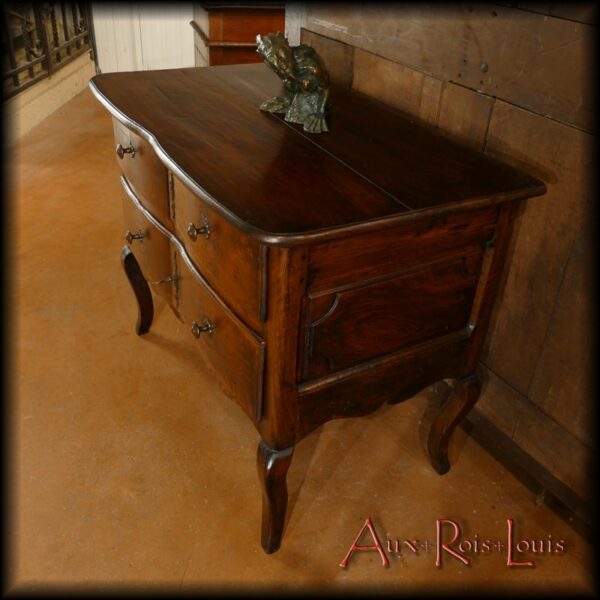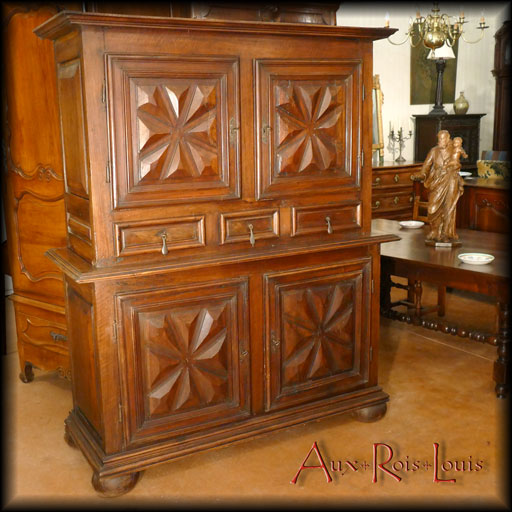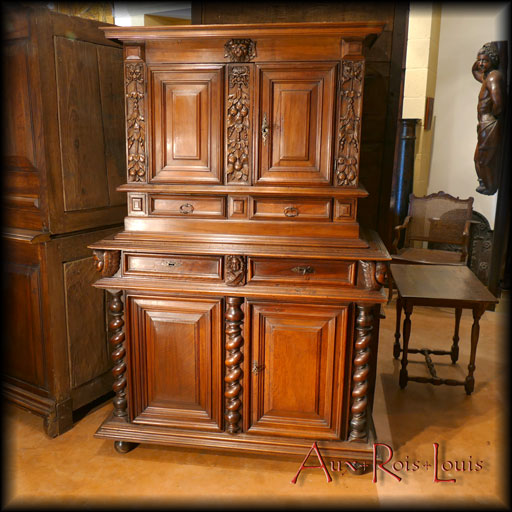Polychrome Walnut Virgin with Serpent – 18th Century – Midi-Pyrénées – [ME116]
Explore the iconic 18th-century polychrome walnut sculpture depicting the Virgin Mary triumphing over a serpent, symbolizing the Immaculate Conception. Standing gracefully with arms wide open on a half-globe, the Virgin crushes the serpent beneath her bare foot. The finely carved piece showcases intricate details, from the peaceful expression on Mary’s face to the polychromatic hues highlighting the mystical nature of the artwork. Uncover the hidden symbolism as the serpent holds an apple, representing the Virgin as the new Eve who, in the 17th century context, erases the transgressions of the first woman. The dimensions of this masterpiece are 56 cm in height, 32 cm in width, and a diameter of 21 cm. [Reference: ME116]

![Polychrome Walnut Virgin with Serpent – 18th Century – Midi-Pyrénées – [ME116] Polychrome Walnut Virgin with Serpent – 18th Century – Midi-Pyrénées – [ME116]](https://www.aux-rois-louis.com/wp-content/uploads/2023/10/ME116_P1670078-600x600.webp)

![Inseparable salt and flour boxes in walnut - 18th century - Provence - [MP025]](https://www.aux-rois-louis.com/wp-content/uploads/2021/11/MP025_153x900-600x600.jpg)
![Two Twisted Walnut Columns – 18th Century – Midi-Pyrénées – [ME105] Here are two impressive twisted walnut columns from the 18th century. Initially, they adorned the base of the monumental staircase in a public building located in the Midi-Pyrénées region. Now, they are prepared to enhance the charm of a film set or a private residence.](https://www.aux-rois-louis.com/wp-content/uploads/2023/07/ME105_P1660601x1200-600x600.jpg)
![Musician’s Lectern in Walnut – Late 18th century – Southwest region of France – [ME109] Here is an antique musician's lectern made of walnut from the 18th century in the Southwest region of France. It features a double openwork music stand resting on a solid wooden tablet, which contributes to its stability. Its base consists of three legs arranged in the manner of tree roots, ensuring its balance.](https://www.aux-rois-louis.com/wp-content/uploads/2023/07/ME0109_P1660615-600x600.webp)
![Louis XIII style walnut reception table – 19th century – Périgord – [ME092] Louis XIII style walnut reception table – 19th century – Périgord – [ME092]](https://www.aux-rois-louis.com/wp-content/uploads/2022/12/ME092_491-600x600.webp)
![Two inseparable walnut armed chairs – Louis XIII – Quercy – [ME089] Examples of seats considered comfortable under Louis XIII, here are two armed chairs with almost straight backrests whose softness lies rather in the way of the armrests, finished in a butt, and the turning, in the Renaissance spirit, of the uprights connecting backrests and armrests at the base.](https://www.aux-rois-louis.com/wp-content/uploads/2022/12/ME089_448C-600x600.webp)
![Walnut drop-leaf writing desk – 18th century – Périgord – [ME090] Drop-leaf secretary made in Périgord in the 18th century in beautiful walnut boards. It is composed of a crossbow chest of drawers with two large drawers, surmounted by a sloping flap that opens to become a writing desk.](https://www.aux-rois-louis.com/wp-content/uploads/2022/12/ME090_P1660457b-600x600.webp)
![Walnut community table – 19th century – South West of France – [ME088] Large walnut community table from a monastery in the South West of France. It is three meters long and can easily accommodate a dozen guests.](https://www.aux-rois-louis.com/wp-content/uploads/2022/12/ME088_P1660439-600x600.webp)
![Chest of Maison Forte in blond walnut – 17th century – Périgord – [ME078] Chest in blond walnut from the 17th century, from a Maison Forte du Périgord. It is decorated with a succession of eight projecting double tables or "chocolate plates", a typical Louis XIII motif. These motifs carved in the mass are two in number on each side and four on the front.](https://www.aux-rois-louis.com/wp-content/uploads/2022/09/ME078_P1660152-600x600.webp)
![Chest of Knight in walnut – 18ᵗʰ century – Périgord – [ME081] Large walnut chest with straight lines ordered and shaped in the County of Périgord in the 18th century. This geographical origin is attested by a typically Périgord motif of an inverted V which houses the keyhole. The ironwork, lock, hinges and handles are all original.](https://www.aux-rois-louis.com/wp-content/uploads/2022/08/ME081_253-600x600.webp)
![Small two-piece walnut sideboard – 18ᵗʰ century – South West France – [ME073] Small two-piece sideboard made in the 18th century in the South West of France. It has a cornice, a picture rail and two largely molded drawers, four doors decorated with diamond points and it rests on two straight feet at the back and two onion feet at the front.](https://www.aux-rois-louis.com/wp-content/uploads/2022/08/ME073_P1660102n-600x600.webp)
![Walnut bonnetière – Louis XIV – 17ᵗʰ century – Périgord – [ME082] Walnut bonnetière – Louis XIV – 17ᵗʰ century – Périgord – [ME082]](https://www.aux-rois-louis.com/wp-content/uploads/2022/08/ME082_P1660256-600x600.webp)
![Walnut sideboard – 18ᵗʰ century – South-West – [MP030]](https://www.aux-rois-louis.com/wp-content/uploads/2022/04/MP030_740-600x600.jpg)
![Louis XIII credenza in walnut – 17ᵗʰ century – South-West – [ME071]](https://www.aux-rois-louis.com/wp-content/uploads/2022/03/ME071_P1650727x900-600x600.jpg)
![Small walnut sideboard – Louis XIV – 17ᵗʰ century – Périgord – [ME069]](https://www.aux-rois-louis.com/wp-content/uploads/2021/12/ME069_P1650574x900-600x600.jpg)
![Walnut storage cabinet – 18ᵗʰ century – France – [ME066]](https://www.aux-rois-louis.com/wp-content/uploads/2021/11/ME066_P1650134x900-600x600.jpg)
![Walnut pantry cabinet - 19th century - Provence - [MP026]](https://www.aux-rois-louis.com/wp-content/uploads/2021/11/MP026_P1650178x900-600x600.jpg)
![Walnut sideboard with scallop shell – Louis XV – 18th century – Lot Valley – [ME067]](https://www.aux-rois-louis.com/wp-content/uploads/2021/11/ME067_144-600x600.jpg)



![ME061_P1610002 Walnut dresser – 17ᵗʰ century – South West France – [ME061]](https://www.aux-rois-louis.com/wp-content/uploads/2021/08/ME061_P1610002-600x600.jpg)



![ME053_P1600527 Office cabinet in walnut - Louis XIII - 17th century - Périgord - [ME053]](https://www.aux-rois-louis.com/wp-content/uploads/2021/04/ME053_P1600527-600x600.jpg)
![MP020_P1600516x900 Louis XV style country sideboard in walnut, oak and elm – 19ᵗʰ century – South West – [MP020]](https://www.aux-rois-louis.com/wp-content/uploads/2021/04/MP020_P1600516x900-600x600.jpg)
![ME052_P1600504 Curved chest of drawers in nuanced blond walnut – 18ᵗʰ century – Périgord - [ME052]](https://www.aux-rois-louis.com/wp-content/uploads/2021/04/ME052_P1600504-600x600.jpg)
![ME051_P1600475 Renaissance style chest in walnut - 17ᵗʰ century - Périgord - [ME051]](https://www.aux-rois-louis.com/wp-content/uploads/2021/04/ME051_P1600475-600x600.jpg)
![ME050_464 Shrunken two bodies sideboard in walnut - Louis XIII - Périgord - [ME050]](https://www.aux-rois-louis.com/wp-content/uploads/2021/04/ME050_464-600x600.jpg)
![ME049_P1600325 Mazarin desk in walnut - Louis XIV - South West - [ME049]](https://www.aux-rois-louis.com/wp-content/uploads/2021/02/ME049_P1600325-600x600.jpg)
![ME045_P1600266 Louis XVI walnut chest of drawers – Late 18ᵗʰ century – South West – [ME045]](https://www.aux-rois-louis.com/wp-content/uploads/2021/02/ME045_P1600266-600x600.jpg)
![MP017_P1600257 Oval walnut cellar table – 18ᵗʰ century – Lot – [MP017]](https://www.aux-rois-louis.com/wp-content/uploads/2021/02/MP017_P1600257-600x600.jpg)
![ME039_P1600103 Louis XVI walnut chest of drawers – Late 18ᵗʰ century – Sud-Ouest – [ME039]](https://www.aux-rois-louis.com/wp-content/uploads/2020/11/ME039_P1600103-600x600.jpg)
![ME043_P1600159 Louis XV style “homme-debout” in walnut - 18ᵗʰ century - Périgord - [ME043]](https://www.aux-rois-louis.com/wp-content/uploads/2020/11/ME043_P1600159-600x600.jpg)
![P1600115c800 Mazarin desk in walnut, oak and pear – Louis XIV – 17ᵗʰ century – South-West – [ME040]](https://www.aux-rois-louis.com/wp-content/uploads/2020/10/P1600115c800-600x600.jpg)
![ME038_670 Curved chest of 4 drawers in walnut – 18ᵗʰ century – Rhône Valley [ME038]](https://www.aux-rois-louis.com/wp-content/uploads/2020/09/ME038_670-600x600.jpg)




![Walnut wood chest – 18ᵗʰ century – Bordeaux Region Walnut wood chest – 18ᵗʰ century – Bordeaux Region – [ME005]](https://www.aux-rois-louis.com/wp-content/uploads/2022/07/ME005_N04_P1350548_2-600x600.webp)
![Louis XIV walnut armoire – late 17ᵗʰ century – Périgord Louis XIV walnut armoire – late 17ᵗʰ century – Périgord – [ME002]](https://www.aux-rois-louis.com/wp-content/uploads/2022/07/ME002_P1500449carrex800-600x600.webp)


![Walnut coffer – 18ᵗʰ century – Périgord Walnut coffer – 18ᵗʰ century – Périgord – [ME010]](https://www.aux-rois-louis.com/wp-content/uploads/2022/07/ME010_N10_P1500391-600x600.webp)